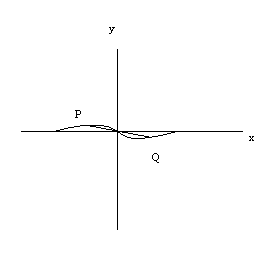Graphs and Symmetry
-
Symmetry (Geometry)
Definition
We say that a graph is symmetric with respect to the y axis if for every point (a,b) on the graph, there is also a point (-a,b) on the graph.
Visually we have that the y axis acts as a mirror for the graph. We will demonstrate several functions to test for symmetry graphically using the graphing calculator.

Definition
We say that a graph is symmetric with respect to the x axis if for every point (a,b) on the graph, there is also a point (a,-b) on the graph.
Visually we have that the x axis acts as a mirror for the graph. We will demonstrate several functions to test for symmetry graphically using the graphing calculator.
Definition
We say that a graph is symmetric with respect to the origin if for every point (a,b) on the graph, there is also a point (-a,-b) on the graph.
Visually we have that given a point P on the graph if we draw a line segment PQ through P and the origin such that the origin is the midpoint of PQ, then Q is also on the graph.

We will use the graphing calculator to test for all three symmetries.
-
Symmetry (Algebra)
Examples:
-
x-axis Symmetry
To test algebraically if a graph is symmetric with respect the x axis, we replace all the y's with -y and see if we get an equivalent expression.
-
For
x - 2y = 5
we replace with
x - 2(-y) = 5
Simplifying we getx + 2y = 5
which is not equivalent to the original expression.
-
For
x3 - y2 = 2
we replace with
x3 - (-y)2 = 2
which is equivalent to the original expression, so that
x3 - y2 = 2
is symmetric with respect to the x axis.
-
-
y-axis Symmetry
To test algebraically if a graph is symmetric with respect to the y axis, we replace all the x's with -x and see if we get an equivalent expression.
-
For
y = x2
we replace with
y = (-x)2 = x2
so that
y = x2
is symmetric with respect to the y axis.
-
For
y = x3
we replace with
y = (-x)3 = - x3
so that
y = x3
is not symmetric with respect to the y axis.
-
-
Origin Symmetry
To test algebraically if a graph is symmetric with respect to the origin we replace both x and y with -x and -y and see if the result is equivalent to the original expression.
-
For
y = x3
we replace with
(-y) = (-x)3
so that
-y = -x3 or y = x3
Hence
y = x3
is symmetric with respect to the origin.
-
-
-
Intercepts
We define the x intercepts as the points on the graph where the graph crosses the x axis. If a point is on the x axis, then the y coordinate of the point is 0. Hence to find the x intercepts, we set y = 0 and solve.
Example:
Find the x intercepts ofy = x2 + x - 2
We set y = 0 so that
0 = x2 + x - 2 = (x + 2)(x - 1)
Hence that x intercepts are at (-2,0) and (1,0)
We define the y intercepts of a graph to be the points where the graph crosses the y axis. At these points the x coordinate is 0 hence to fine the y intercepts we set x = 0 and find y.
Example:
Find the y intercepts of
y = x2 + x - 2
Solution:
We set x = 0 to get:
y = 0 + 0 - 2 = -2.Hence the y intercept is at (0,-2).
Back to the Math Department Home
e-mail Questions and Suggestions